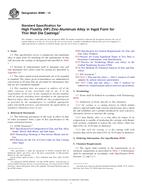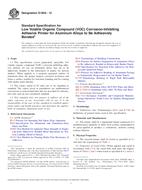Potřebujeme váš souhlas k využití jednotlivých dat, aby se vám mimo jiné mohly ukazovat informace týkající se vašich zájmů. Souhlas udělíte kliknutím na tlačítko „OK“.
ASTM G69-12
Standard Test Method for Measurement of Corrosion Potentials of Aluminum Alloys
Automaticky přeložený název:
Standardní zkušební metoda pro měření korozních potenciálů z hliníkových slitin
NORMA vydána dne 1.5.2012
Informace o normě:
Označení normy: ASTM G69-12
Poznámka: NEPLATNÁ
Datum vydání normy: 1.5.2012
Kód zboží: NS-57783
Počet stran: 5
Přibližná hmotnost: 15 g (0.03 liber)
Země: Americká technická norma
Kategorie: Technické normy ASTM
Kategorie - podobné normy:
Anotace textu normy ASTM G69-12 :
Keywords:
aluminum alloy, aqueous, copper, corrosion potential, sodium chloride, solid solution, zinc, ICS Number Code 77.120.10 (Aluminium and aluminium alloys)
Doplňující informace
| Significance and Use | ||||||||
|
The corrosion potential of an aluminum alloy depends upon the amounts of certain alloying elements that the alloy contains in solid solution. Copper and zinc, which are two of the major alloying elements for aluminum, have the greatest effect with copper shifting the potential in the noble or positive direction, and zinc in the active or negative direction. For example, commercially unalloyed aluminum (1100 alloy) has a potential of –750 mV when measured in accordance with this method, 2024–T3 alloy with nearly all of its nominal 4.3 % copper in solid solution, a potential of –600 to –620 mV, depending upon the rate of quenching and 7072 alloy with nearly all of its nominal 1.0 % zinc in solid solution, a potential of 885 mV (SCE) (1-3). Because it reflects the amount of certain alloying elements in solid solution, the corrosion potential is a useful tool for characterizing the metallurgical condition of aluminum alloys, especially those of the 2XXX and 7XXX types, which contain copper and zinc as major alloying elements. Its uses include the determination of the effectiveness of solution heat treatment and annealing (1), of the extent of precipitation during artificial aging (4) and welding (5), and of the extent of diffusion of alloying elements from the core into the cladding of Alclad products (2). |
||||||||
| 1. Scope | ||||||||
|
1.1 This test method covers a procedure for measurement of the corrosion potential (see Note 1) of an aluminum alloy in an aqueous solution of sodium chloride with enough hydrogen peroxide added to provide an ample supply of cathodic reactant. Note 1—The corrosion potential is sometimes referred to as the open-circuit solution or rest potential. See Practice G193. 1.2 The values stated in SI units are to be regarded as standard. No other units of measurement are included in this standard. 1.3 This standard does not purport to address all of the safety concerns, if any, associated with its use. It is the responsibility of the user of this standard to establish appropriate safety and health practices and determine the applicability of regulatory limitations prior to use. |
||||||||
| 2. Referenced Documents | ||||||||
|
Podobné normy:
Historická
1.6.2014
Historická
1.12.2010
Historická
15.3.2011
Historická
15.2.2010
Historická
1.9.2011
Historická
1.11.2012



 ASTM B989-14
ASTM B989-14 ASTM D4340-10
ASTM D4340-10 ASTM E1251-11
ASTM E1251-11 ASTM E127-10
ASTM E127-10 ASTM E1793-11
ASTM E1793-11 ASTM E1826-12
ASTM E1826-12
 Cookies
Cookies
